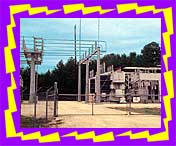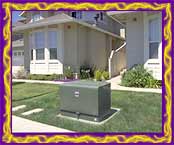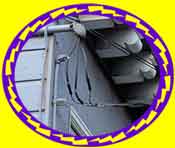![]()
|
|
 When
you want to use electricity, you plug an electrical
appliance, toy, or tool into the tiny holes in an outlet.
Does electricity come from the tiny holes? Well, yes and
no.
When
you want to use electricity, you plug an electrical
appliance, toy, or tool into the tiny holes in an outlet.
Does electricity come from the tiny holes? Well, yes and
no.
Electricity travels in a "circuit" that begins at a power plant. A thick coil of wire spins inside giant magnets at the plant, moving the electrons in the wire and making electricity flow.
 The
power plant sends electricity through a grid of power lines.
First, big transmission wires on tall towers carry
electricity to places called "substations" in different
neighborhoods. These substations contain equipment that
reduces electricity's voltage so it can travel on smaller
power lines that branch out down streets, either on overhead
power lines or lines that are buried underground.
The
power plant sends electricity through a grid of power lines.
First, big transmission wires on tall towers carry
electricity to places called "substations" in different
neighborhoods. These substations contain equipment that
reduces electricity's voltage so it can travel on smaller
power lines that branch out down streets, either on overhead
power lines or lines that are buried underground.
 Overhead
and underground power lines carry electricity to
transformers on poles or on the ground, where the voltage of
electricity is reduced again so people can use it safely.
(Transformers and substations contain equipment that is very
dangerous to touch; that's why they have warning signs on
them.)
Overhead
and underground power lines carry electricity to
transformers on poles or on the ground, where the voltage of
electricity is reduced again so people can use it safely.
(Transformers and substations contain equipment that is very
dangerous to touch; that's why they have warning signs on
them.)
 From
transformers, electricity travels into buildings through
wires called service drops. These connect to a meter box,
which measures how much electricity is being used, and to
all the wires that run inside walls to outlets and switches.
From
transformers, electricity travels into buildings through
wires called service drops. These connect to a meter box,
which measures how much electricity is being used, and to
all the wires that run inside walls to outlets and switches.
When you plug something in and turn it on you complete electricity's circuit. Electricity flows from the wires in the wall, through the plug's metal prongs, and through the appliance cord to the motor of the appliance. Then it flows back through the appliance cord to the outlet and out to the wires and into the grid again.
So, while electricity doesn't actually come from the little holes in outlets, it is waiting inside the outlet to be used-much like water waits in pipes for you to turn on the faucet and let it flow.
